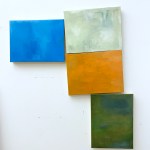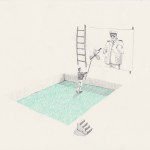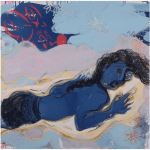
After exploring hard-edge abstraction and unconventional materials for decades, Regina Bogat began incorporating a more gestural approach into her work. These paintings, made in the 1990s, are on view at Z�rcher Gallery, NY, through March 2. Her daughter Anna Bogat Jensen wrote the following essay for Bogat’s exhibition catalogue.
Contributed by Anna Bogat Jensen / In the 1990s, Regina Bogat found a new way of working. In a dramatic shift, she turned from the hard-edge geometric abstraction that dominated her oeuvre since the 1960s and gradually shed the unconventional materials, namely cords and wooden sticks, that graced her canvases of prior decades. Instead, the brushstrokes characteristic of her early Abstract Expressionist period took on renewed vigor and importance. The sticks that she previously placed horizontally at intervals were now fanned out or applied vertically before being abandoned, all together, as in Untitled 12 (1998). Gray, painterly washes were used as backgrounds. Thread and wool were taken up again, but in entirely new ways, as in Cy (1993) and the Homage to Max Ernst collages (1991). In a notable experiment, the artist laid one freshly painted canvas face down upon another and then rubbed the back of the top canvas. Scraping, pouring, applying dry pigment and layering were among the techniques Bogat employed in the 1990s, creating works with great depth and texture.


This Way That (1990) can be viewed as a visual depiction of Bogat�s state of mind in the 1990s. Whereas her work usually reflects its historical context, in This Way That she unconsciously depicts her own history. One might even consider it a self-portrait. The series of colorful painted squares on the wood sticks run in opposite directions above and below. The center of vibrant brushstrokes bursts with energy as it projects from the light-washed background against a darker cool gray. Bogat, an explorer, is searching through her past and moving into the future, looking for new techniques, excited yet unsettled, seeking, going this way and that. She is between two currents, looking backward to prior techniques and looking forward in search of new developments. Indeed, This Way That is a perfect depiction of Bogat�s transitional decade; and it was prophetic because she painted it in 1990.
As an avid reader and traveler, Bogat draws inspiration from ancient cultures and the natural world. Chinese hexagrams are featured in her 1960s paintings and box sculptures; Chinese sacred mountains are represented in The Phoenix and the Mountain series of the 1980s; and Egyptian canopic chests inspired the 1980s Memorial Boxes. A striking example of Bogat drawing inspiration from an ancient culture is The Phoenix and The Mountain #2 (1980), influenced by her visit to the Peruvian Nazca lines. In the summer of 1963, Bogat drove across the United States and was struck by the austere beauty of the Southwestern landscape. Thirty years later she became fascinated with Native American legends of the Southwest, which triggered her memories of the primal desert terrain.

Stone of Sky (1993) is evocative of turquoise, a legendary stone representing something fundamental to many Native American cultures. In 1993, Bogat read Carol Karasik�s book, The Turquoise Trail (Harry Abrams, 1993). The title of the first chapter, �Stone of Sky,� describes the symbolic importance of turquoise to the Pueblo peoples of the Southwest. When turquoise was introduced to the Maya area via trade routes by 1000 CE, it replaced jade as the most precious material, representing both sky and water. Native Americans living in arid regions held ceremonies for rain. According to myths, when the rain poured from the sky and was absorbed into the earth, turquoise was created. It was a stone from the sky transported by water, as its color clearly indicates. Bogat�s painting perfectly depicts the arid Southwestern region, the hoped-for clouds and thunderstorms, and the turquoise believed to grow as a result. The painted wooden stick represents the porous earth, and the white paint, glowing between the stick and the turquoise paint, conveys the mystical transformation. When Karasik viewed Bogat�s Stone of Sky, she said, �The mustard yellow is the color of Hopi corn fields in the desert of Arizona. Beautiful.�
Bogat read the first four volumes of Sir Joseph Needham�s Science and Civilization in China (Cambridge University Press, 1954) and studied the Chinese collection at the Metropolitan Museum in New York. She traveled extensively throughout China in the mid-1980s with a small art and architecture tour arranged by an artist who invited her to join the group. As many of her 1990s paintings show, the journey across China�s rugged landscape had a profound influence on Bogat�s life and art. Bogat captures the smoky, translucent glazes enriching Chinese ceramics, paintings, and scrolls. The gestural brushstrokes she first employed during the 1950s returned, this time inspired by Chinese brushstrokes. The painting, Jeanette (1993), is an expressive rendition of the Chinese character meaning �have,� although Bogat was not aware she had painted a word. She respected the training and discipline historically required of Chinese artists and especially admired their expertise at working with ink. She experimented with this medium and used black acrylic to similar effect in a strong body of paintings.

Among them is Wuxi (1994), a gemmy painting, alive with weight and smoky mystery. The painted wood sticks provide structure as they accentuate, contain, and organize the amorphous yellow landscape. The sticks also create perspective as they make the yellow landscape recede. The nearby town of Suzhou, in China�s Jiangsu Province, harbors some of the most exquisite Scholars� Gardens. When Bogat visited, the ancient retreats had just been restored, and she was able to fully appreciate an architectural style that provided different contemplative views in every direction. The magnificent rocks from Lake Tai, often depicted in Chinese paintings, were a feature of the gardens. The painting Wuxi evokes the silence of the Scholars� Gardens and their emotional impact upon the artist.

Bogat also visited the Summer Palace, an Imperial Garden in Beijing. Unlike the Great Wall, which she found to be an exuberant structure, the garden of the Summer Palace seemed gloomy in its formality. Bogat�s painting, The Garden of The Last Empress (1990), celebrates the power of the Empress Dowager Cixi in the years when she reigned supreme (1861-1908). Throughout her oeuvre, Bogat invokes strong and brave women, including Jeanne D�Arc (1969), Homage to Paula Modersohn- Becker (1983) and Zenobia (2015). Indeed, Bogat finds strong women throughout her background: her paternal grandmother ran her own business in the early 1900s, as did Bogat�s mother during the 1940s and 1950s. It is not surprising, then, that Bogat became fiercely independent.

Expressionist brushstrokes also appear in a series of collages Bogat calls Homage to Max Ernst (1991). She owes much to Max Ernst, on both formal and conceptual levels. She learned three techniques from him, examples of which can be found in her 1990s work: scraping (grattage), rubbing (frottage), and collage, at which he was an expert. However, the most important gift Ernst gave to Bogat was freedom�the freedom to invent new techniques and styles in art. For him, all techniques and styles, from Dada to Surrealism, opened possibilities for experiment. When he wanted to innovate, he aimed for technical excellence, a product of his early German art school training. In Bogat�s three collages dedicated to him, she felt free to cut sections and sew paper together, making long stiches with heavy thread. The underneath-and-above effect discovered in this exercise would be further developed in her star paintings the following decade.

Anomaly (1990) conveys the idea of chance in painting and exemplifies Bogat�s playful dialogue with her work. It is one of the first examples of her original technique: pressing a freshly painted canvas against another, then rubbing the back of the top canvas, which often results in beautiful, organic, sea coral-like patterns. This effect is seen throughout her oeuvre since the 1990s, and she considers the method to be her own frottage, inspired by Ernst. Although the main shape in Anomaly came about largely through chance, the silvery dark grey circles echo the Sculp-metal painted wood dowels of her 1960s work. All are floating abstractions. The central image wants to float away, to become airborne, but it is restrained by the painted wood stick. The dots float behind the image, creating more depth and space.
Ignored because of the rampant sexism of the time, Bogat never gave up. Since the 1960s, she relentlessly pursued her vision, regardless of what other artists were doing or what the art world might think. Unafraid to try new techniques and styles, she consistently created original work that was prescient of artistic interests to come. Yet there are definite connections linking all decades of her work: superb use of color; a playful dialogue with her paintings; working with order and disorder; recurring visual themes that appear in fresh ways; and drawing inspiration from ancient cultures and the natural world.
Bogat�s creative and inventive work, while consistently ahead of its time, also reflects the historical eras in which she worked. Her oeuvre provides a poetic visual history of each decade, which can be seen quite strikingly in the 1990s work. The 1990s was the decade of deconstruction: torn denim, the grunge look, and a return to minimalism. French philosopher, Jacques Derrida, and his concept of deconstruction were vital to the 90s’ cultural world. When Bogat went to hear Derrida speak at Seton Hall�s Lecture Series, she recalls someone in the audience asking him, �What is deconstruction?� The philosopher replied, �Deconstruction is the United States.� In the 1960s, Bogat�s hard edge, syncopated, and colorful abstractions reflect the era. In the 1970s, when the trend was all hair and fringe, she produced her threaded and cord work, such as Cord Painting 14 (1977) and Cord Painting 15 (1977). The 1980s, a period of structured fashion, bright colors, and the baby-boomers� existential transformation, is well represented in her structured and vividly colorful Memorial Boxes and The Phoenix and The Mountain series. The work of the 1990s is another accurate historical reflection.
In Bogat�s office, just off her studio, rests a small framed collage she calls Life is Terrifying (1975). It incorporates an image of Cezanne, who influenced Bogat throughout her career; it also incorporates a quotation fragment she clipped, along with the image, from some publication long ago. It reads: � his father�s bank. But the desire to be an artist was too strong and he soon returned to his first love and painted out the rest of his life in Paris and the Midi. �Life is terrifying,� Cezanne used to say. Abandoning the security of bourgeois life and taking the risk to be an artist is terrifying, indeed. Cezanne made the right choice. He won in the end and so has Bogat.
“Bogat in The 90s: The Decade of Deconstruction,” Z�rcher Gallery, NY, Noho, New York, NY. Through March 2, 2018
Related posts:
Mary Heilmann retrospective: injecting vernacular juice into abstract art
David Reed: A painter�s life
Sweet direction for Carolanna Parlato
LOVE: Robert Indiana�s hard-edged visual essays















Thank you Sharon
Great idea to publish Anna Bogat’s essay on Regina Bogat
Works in the 90’s !
Enjoy reading it before visiting the show at Zurcher gallery
So interesting!–thank you.